Acacia Trees: Types, Leaves, Flowers, Thorns – Identification (With Pictures)
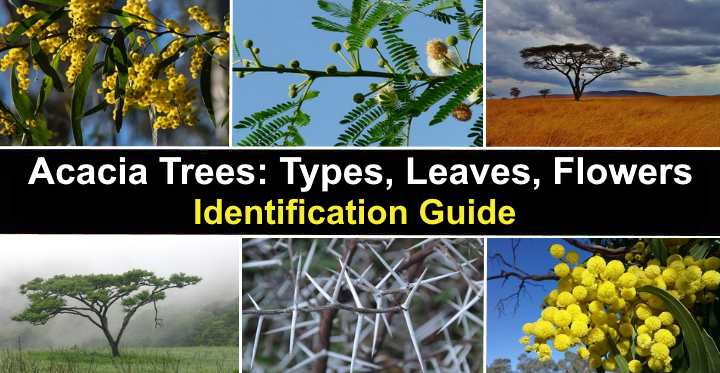
Acacia trees and shrubs are an evergreen plant species with unique fern-like leaves and showy clusters of fragrant yellow or white fuzzy flowers. The unusual feature of feathery acacia leaves is that they are a type of modified stem or petiole. Acacias are fast-growing thorny trees and shrubs with many uses in a garden landscape.
Also called wattles, acacia plants can be trees and shrubs of varying sizes. Large acacia trees such as the Sweet Acacia (Acacia farnesiana), Silver Wattle (Acacia dealbata), and Cootamundra Wattle (Acacia baileyana) grow between 20 and 50 ft. (6 – 15 m) tall. Smaller acacia bushes like the Flax-Leaf Wattle (Acacia linifolia) or Box Leaf Wattle (Acacia buxifolia) can grow as short as 3 or 4 ft. (1 – 1.2 m).
This article is a complete guide to identifying the most popular types of acacia trees and shrubs. Descriptions and pictures of plants in the Acacia genus will help identify the best ornamental trees or bushes for your sunny garden.
Acacia Tree Care
Acacia plants grow best in full sun and well-draining, loamy, or sandy soil. The drought-tolerant plant hardly needs any water after it’s established in the landscape. It’s a trouble-free, low-maintenance evergreen plant that keeps its foliage and fluffy blooms during winter and spring without much care.
Occasional pruning in the dry season is enough to keep the Acacia trees looking their best.
Acacia Tree Facts

Acacia trees and shrubs can be of varying sizes and are tolerant of dry, arid conditions
Acacias are a large genus of graceful trees and attractive shrubs in the genus Acacia and pea family Fabaceae. Acacia plants also belong to the subfamily Mimosoideae. Many species of Acacia are native to Australia, and some are native to Africa. In North America, acacias grow in warm states such as Texas, Arizona, and California.
In its native Australia, reports say that there are over 1,000 species of Acacia, and it’s the country’s largest genus of flowering plants. On African savannas, acacia trees with their large spreading umbrella-like canopies are well-known landmarks.
Because acacia trees are tolerant of dry, arid conditions, they are also a common desert plant. Acacias are found growing in the deserts of Africa and southern states of the U.S.
Acacia is also a species of fast-growing trees and shrubs. In ideal conditions, its rapid growth rate means that some Acacia species grow as much as 3 ft. (1 m) a year. The trees quickly grow to their mature height of between 20 and 50 ft. (6 – 15 m) tall. Acacias are relatively short-lived and grow between 20 and 30 years.
Species of trees and shrubs in the genus Acacia thrive in USDA growing zones 9 through 11. Most acacias grow best in full sun; however, some are also tolerant of some shade.
There’s also an interesting relationship between acacias and ants. Some ant species help protect acacia trees by attacking insects and even some mammals that want to feed on its foliage. Also, some studies suggest that ants also reduce bacteria pathogens that grow on leaves. In turn, ants live in the hollows of acacia thorns and feed on sweet nectar from the tree.
Acacia Wood
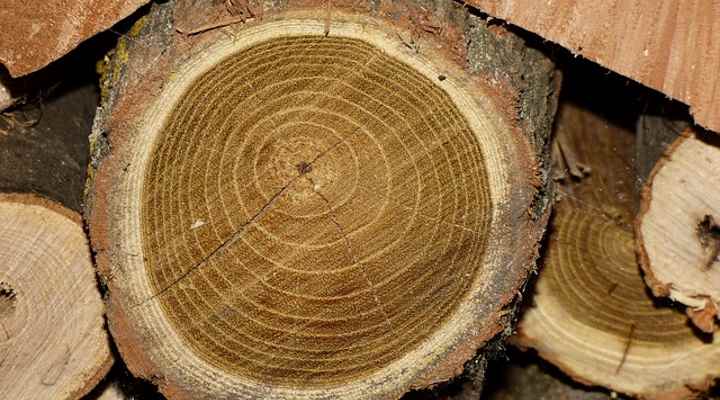
Wood from acacia trees is a dense, durable hardwood used for flooring, furniture, and homewares. Acacia wood has warm, orange tones with an attractive wood grain. A feature of wattle tree wood is its excellent water-resistant properties, even if it’s not treated.
Bark on acacia trees is deeply furrowed and has a gray to brown appearance. Acacia bark has a high tannin content and, because of this, was used in leather making.
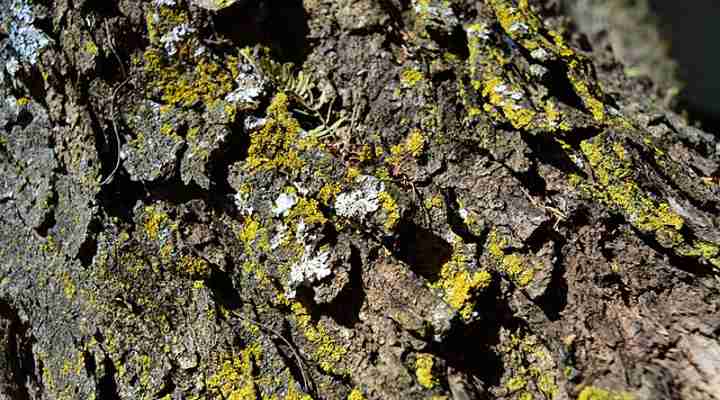
Acacia tree bark
Acacia Leaves
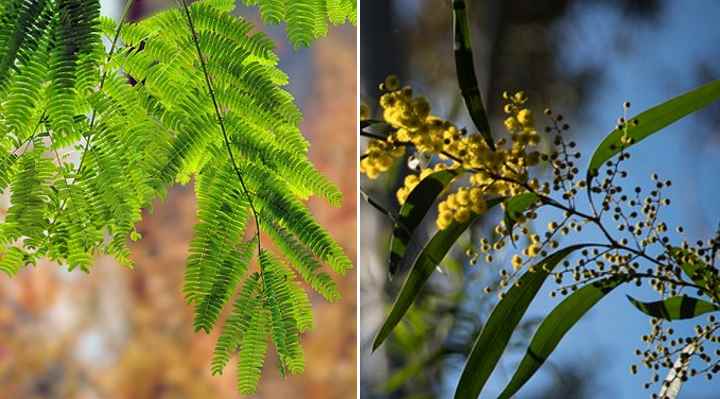
Acacia leaves can be fern-like bipinnate (left) or flattened petioles that act like leaves (right)
Acacia leaves look like fern leaves or leaves from mimosa plants. The bipinnate leaves on acacias consist of small oval leaflets arranged oppositely on leaf stems (petioles). Acacia (wattle) leaves can grow up to 12” (30 cm) long. Leaves can be dark green to silvery bluish-green.
The leaves on some Acacia species are called phyllodes or cladodes. This type of modified leaf is a flattened petiole, but it performs the same function as tree leaves. However, some Acacia tree and shrub species have true leaves that are pinnately compound.
The feathery pinnate leaves on many acacia plants give the shrub or tree a fern-like appearance.
Interestingly, the pinnate or bipinnate juvenile leaves on some acacia tree varieties become single, willow-like, or long linear leaves as they mature.
Acacia Flowers
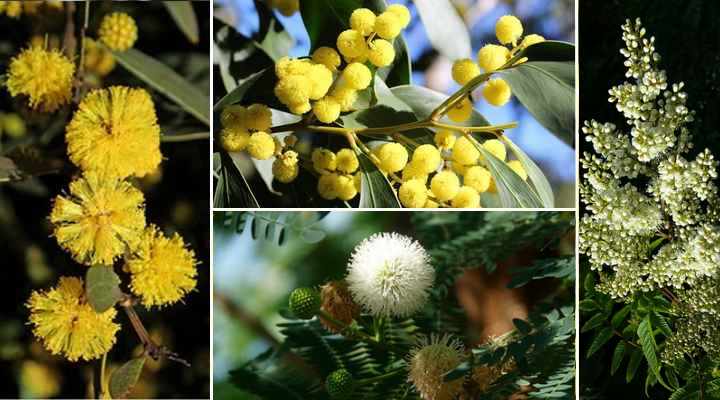
Acacia flower clusters are mainly yellow or creamy-white and have fuzzy appearance
Acacia flowers are showy white or yellow puffballs that grow in compact cylindrical or globular clusters. The flower plumes have a furry or fuzzy appearance due to the many stamens on each acacia flower. Acacia flowers range in appearance from creamy white to golden yellow. There are also some unusual acacia trees with red or purple flowers.
Depending on the acacia species, the beautiful flower clusters can have as few as three fluffy flowers or over 100 densely-packed flowers in the inflorescence.
Unlike other types of flowering trees, the attractive acacia flowers don’t produce nectar. The glands on the phyllodes or leaves secrete sweet nectar that attracts ants, bees, and butterflies.
The Golden Wattle (Acacia pycnantha) flower is the national flower of Australia.
Acacia Thorns
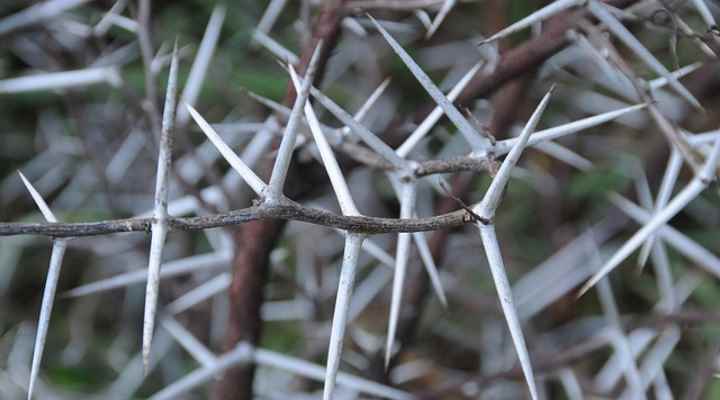
A close up picture of Acacia thorns
Many Acacia species have thorny branches that act as protection for the tree. The long sharp, hard spikes also have an unpleasant taste that deters some animals from munching on their leaves and bark. The thorns on some acacia trees also provide shelter for ants. The ants hollow out acacia thorns and lay eggs, and form colonies on acacia trees.
The sharp, stiff spikes on acacia shrubs make them ideal plants for privacy screens and security hedgerows.
Acacia Fruit
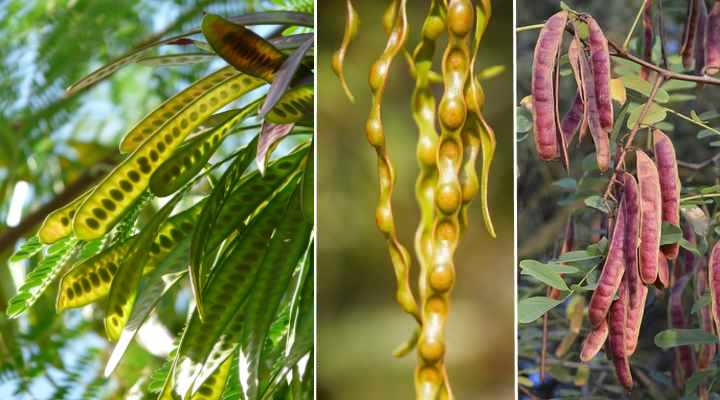
Acacia pods have various shapes and colors depending on the species
Acacia fruit looks like peapods that can be straight, coiled, or twisted. Acacia pods can also be smooth or have a fuzzy texture due to fine hairs on the pods. These pods contain seeds that look like small peas. The pods grow in clusters on acacia trees and can be green, brown, or black.
Acacia Identification
The best way to identify species of Acacia is by the leaves, pods, and flowers. Look for the long fern-like pinnate leaves or flattened petioles to identify the variety of acacia trees. Usually, the easiest way to recognize an Acacia species is by the ball or spiked flowers. Each individual type of acacia usually only has flowers in one specific color. Also, the shape of the leaves is typically unique to each Acacia species.
Types of Acacia (With Pictures)
Let’s look in more detail at identifying the most common acacia trees and shrubs. You’ll find descriptions of acacia leaves, flowers, pods, and thorns to help choose the best flowering plant for your garden.
Willow Acacia (Acacia salicina)
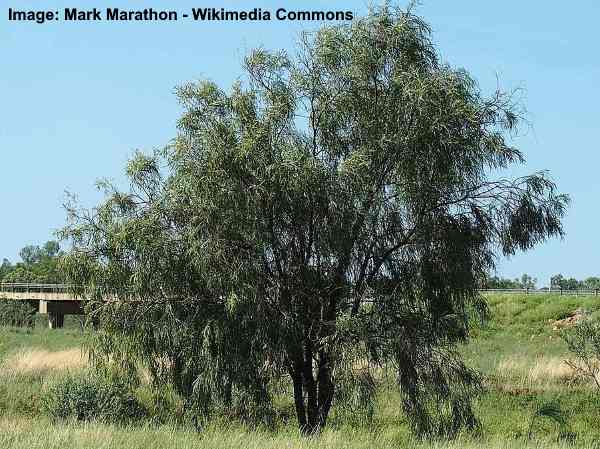
Willow Acacia (Acacia salicina)
The Willow Acacia is a sizeable thornless shrub or small weeping tree with slender linear leaves, brown seed pods, and yellow puffball flowers. Depending on Willow Acacia, the plant grows between 10 and 65 ft. (3 – 20 m). The pendulous branches of the willow acacia tree give it a weeping, drooping appearance.
The Willow Acacia gets its common name from the willow-like leaves and weeping growth. This acacia is also known as ‘Willow Wattle,’ ‘Black Wattle,’ ‘Native Wattle,’ and ‘Cooba.’
This fast-growing, low-maintenance shrubby acacia grows best in warm climates and full sun or partial shade. Being tolerant of drought, you only need to water this acacia every one or two months.
Willow acacia leaves: The acacia leaves are flattened, long slender stalks (phyllodes) that are blue- to dark-green. Leaves grow up to 12” (30 cm) long and 0.8” (2 cm) wide. Willow acacia leaves can be linear to lanceolate.
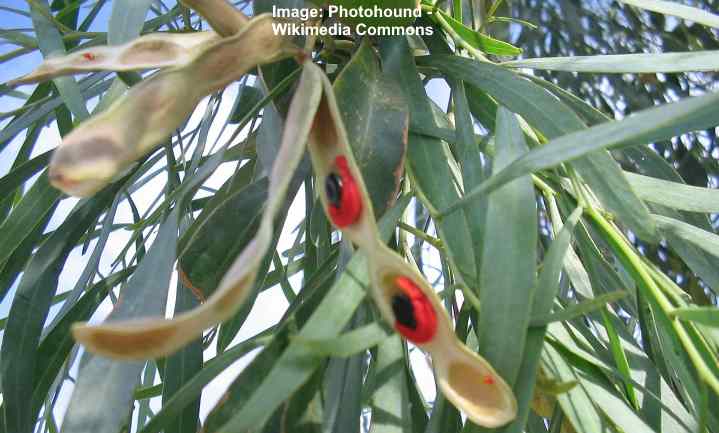
Acacia salicina leaves, pods and seeds
Willow acacia flowers: The acacia flowers look like bright yellow fluffy globular clusters. Each flower cluster has between 25 and 55 fuzzy flowers. Blooming time is in late spring and summer.
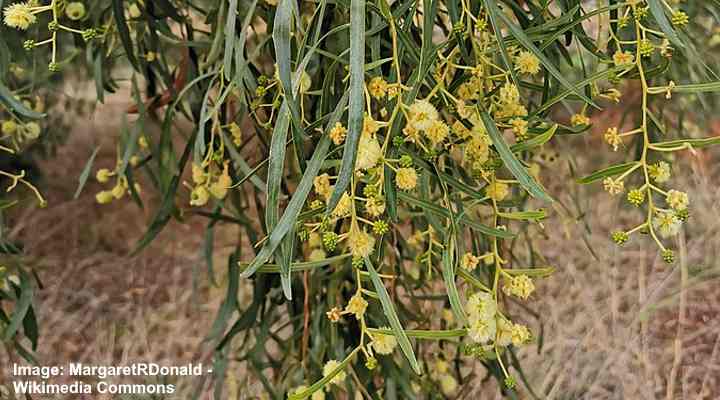
Acacia salicina flowers
Shoestring Acacia (Acacia stenophylla)
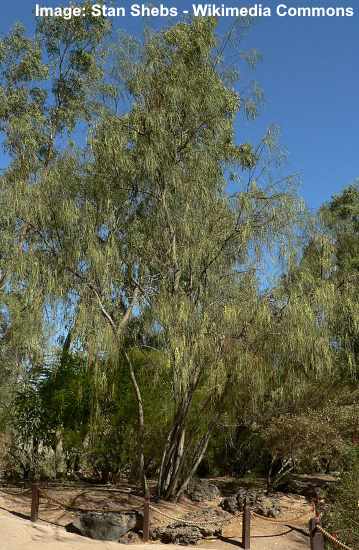
Shoestring Acacia (Acacia stenophylla)
The Shoestring Acacia has long string-like smooth bluish-green leaves and pale-yellow spherical flowers. The Shoestring Acacia grows between 13 and 66 ft. (4 – 20 m) tall and up to 30 ft. (9 m) wide. An identifying feature of Shoestring Acacia is the long seed pods that look like a necklace or rosary beads.
The botanical name—Acacia stenophylla—comes from the unusual narrow acacia leaves. Its name in Greek means a tree with narrow leaves. Due to the string leaves, this acacia tree is excellent for filtered shade.
Another identifying feature of Shoestring Acacia is the long pods that look like a string of beads. The furry seed pods grow up to 10” (26 cm) long and are dark brown.
For best results, grow the Shoestring Acacia in USDA zones 9 – 11, full sun and well-draining ground. Water once a month
Shoestring acacia leaves: The acacia leaves are long string-like modified stems (phyllodes). Leaves grow between 6” and 16” (15 – 40 cm) long and only 0.4” (1 cm) wide. The drooping bluish-green leaves give the Shoestring Acacia a weeping look.
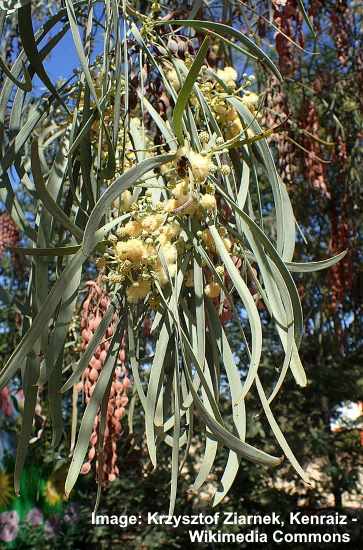
Acacia stenophylla leaves, flowers and pods
Shoestring acacia flowers: Look for clusters of creamy-yellow puffballs growing in between long stringy leaves. The long-blooming acacia tree has flowers from fall until spring.
Sweet Acacia (Acacia farnesiana)
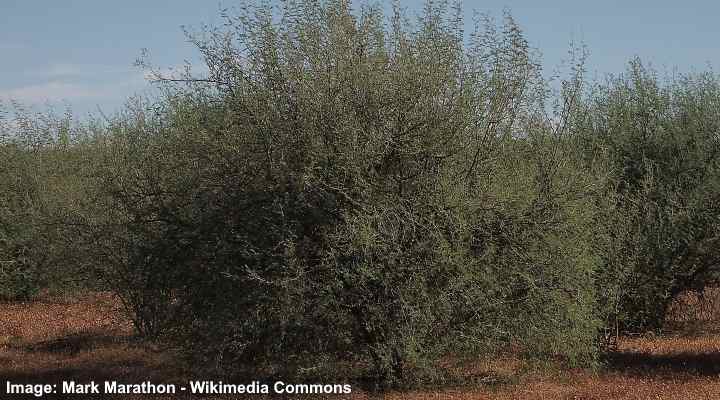
Sweet Acacia (Acacia farnesiana)
The Sweet Acacia is a semi-evergreen, multi-trunked tree with sharp thorns, feathery leaves, and flower clusters of yellow puffballs. This variety of acacia grows between 15 and 20 ft. (4.5 – 6 m) tall. The Sweet Acacia also has a fast growth rate of up to 3 ft. (1 m) per year.
Identifying features of the Sweet Acacia are the plump, cylindrical seed pods, 1-inch (2.5-cm) sharp thorns, and a sweet fragrance.
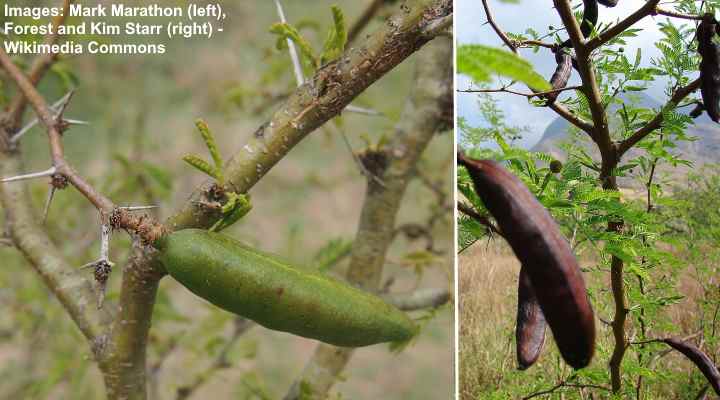
Acacia farnesiana green immature pod and thorns (left) and brown mature pods (right)
The Sweet Acacia also goes by other names such as ‘Texas Huisache,’ ‘Perfume Acacia,’ ‘Needle Bush,’ and ‘Mealy Wattle.’ It also has the botanical name Vachellia farnesiana.
As with all drought-tolerant acacia trees, the Sweet Acacia grows best in full sun, sandy, well-draining soil. Regular pruning helps maintain its height to create a beautiful flowering ornamental acacia tree.
As its name suggests, the Sweet Acacia gives off a delightful scent from its golden yellow blooms.
The Sweet Acacia is a popular tree to grow in Florida, California, and Texas. In USDA zones 9 through 11, the tree keeps some of its beautiful foliage throughout the winter.
The small, feather-like leaves of Sweet Acacia have a pair of sharp thorns. The thorny shrubby Sweet Acacia is an ideal hedge plant for gardens in tropical or subtropical climates. The light gray spines are visible against the green foliage and olive-green or gray stems.
Sweet acacia leaves: The acacia leaves are pinnate leaves with tiny oval leaflets growing along the petiole. The leaves of the Sweet Acacia look like leaves on mimosa plants.
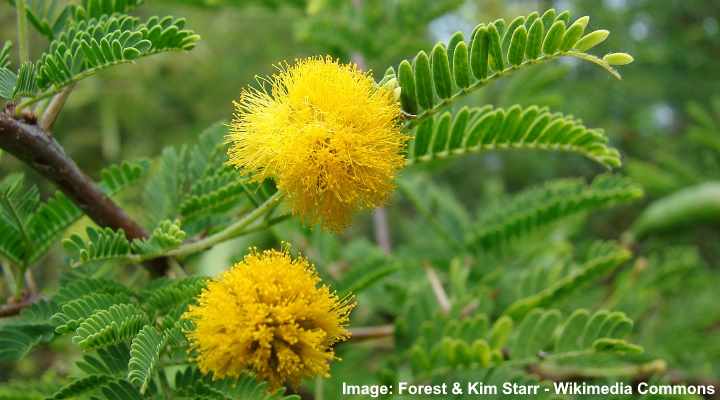
Acacia farnesiana leaves and flowers
Sweet acacia flowers: The Sweet Acacia has yellow flowers that look like fuzzy pom-poms. The bright yellow flower balls grow in clusters and appear in winter or early spring. In warm climates, the acacia tree blooms for most of the year.
Black Acacia (Acacia melanoxylon)

Black Acacia (Acacia melanoxylon)
Also called Blackwood Acacia, this tropical tree has oblanceolate-shaped evergreen leaves, purple fruit, and showy creamy-white flowers. The Black Acacia grows between 40 and 50 ft. (12 – 15 m) tall with a rounded, spreading crown and dense foliage. Pictures of Blackwood Acacia show that it has black or dark brown fissured bark.
Black acacia trees grow best in USDA zones 9 through 11 and prefer full sun. However, they are tolerant of some shade.
Black acacia leaves: The Blackwood wattle has large, silvery-green, or bluish-green leaves which are oblong to ovate shaped. The evergreen acacia leaves grow in an alternate pattern on thick stems.
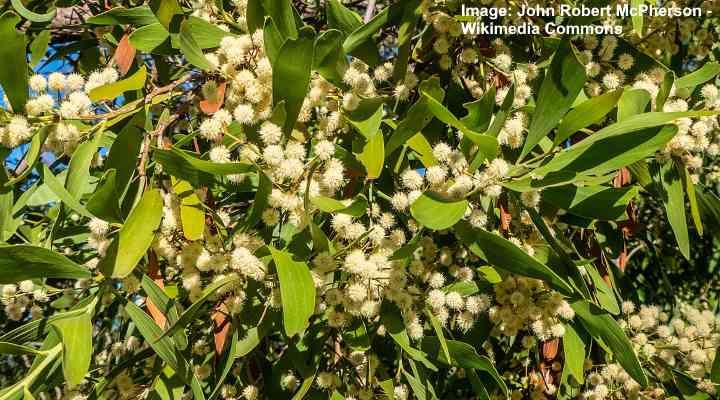
Acacia melanoxylon leaves and flowers
Black acacia flowers: The black acacia has white or cream flowers that appear in spring or winter. The fine, hair-like stamens give the flower puffs a spiky appearance.
Bailey Acacia (Acacia baileyana)
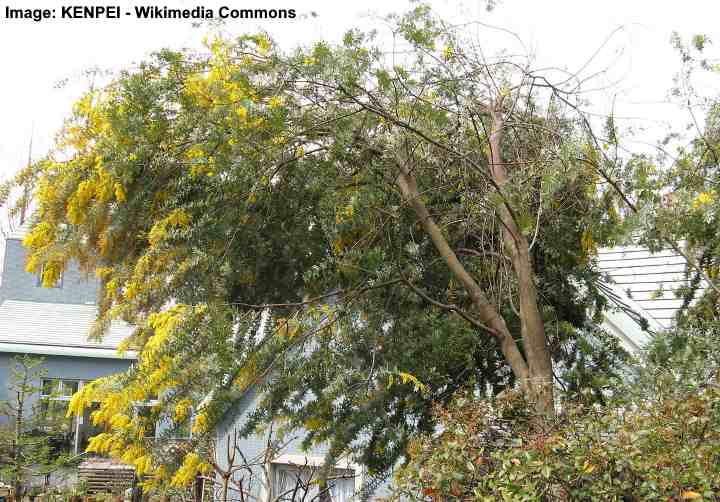
Bailey Acacia (Acacia baileyana)
The Bailey Acacia is a fast-growing shrubby acacia tree with delicate feathery blue-gray leaves, small golden yellow puffy flowers, and brown seed pods. Also called the Cootamundra Wattle, this acacia tree grows up to 30 ft. (10 m) tall. Its identifying feature is the huge, spreading rounded crown with dense silvery gray-green foliage.
Because the acacia leaves on the Bailey Acacia look like those on mimosa plants, the tree is also called ‘Golden Mimosa’ and ‘Fernleaf Acacia.’
The Bailey Acacia is a popular ornamental acacia tree. The appealing qualities of Bailey Acacia tree are the brightly-colored showy flowers that brighten front and backyards. Also, its evergreen foliage gives this acacia year-long appeal.
Bailey acacia leaves: The acacia leaves are small pinnate fern-like leaves made up of tiny blue-green or silver-green oblong leaflets. The identifying feature of the leaves is their short, almost non-existent petioles.

Acacia baileyana flowers and leaves
Bailey acacia flowers: The Cootamundra Wattle blooms with bright, golden-yellow flowers that look like small puffballs. This acacia variety produces flowers between late winter and early spring.
Silver Wattle (Acacia dealbata)
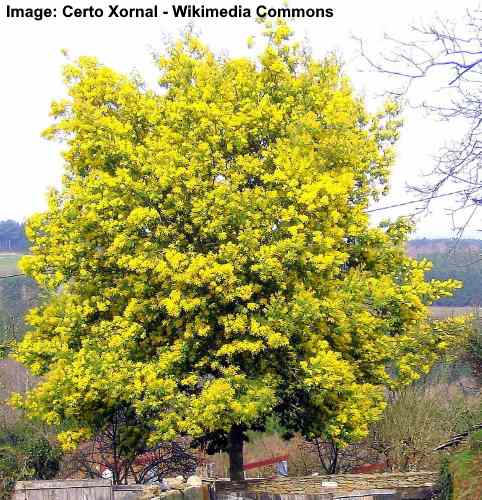
Silver Wattle (Acacia dealbata)
The Silver Wattle is a large evergreen shrub or small tree with silvery-gray twice-compound leaves, golden-yellow globular flowers, and reddish-brown seed pods. This beautiful ornamental yellow acacia is also called ‘Mimosa’ or ‘Blue Wattle.’ This shrub-like tree has rapid growth and grows between 5 ft. and 32 ft. (1.5 – 10 m) tall.
Silver wattle leaves look like mimosa leaves and have pinnate leaves arranged alternately on hairy stalks. The leaves of the mimosa acacia grow between 3” and 6.5” (7 – 17 cm) long and up to 4” (11 cm) wide. The fern-like leaves create dense foliage on a spreading canopy. The Silver Wattle is ideal as a shade tree in garden landscapes.
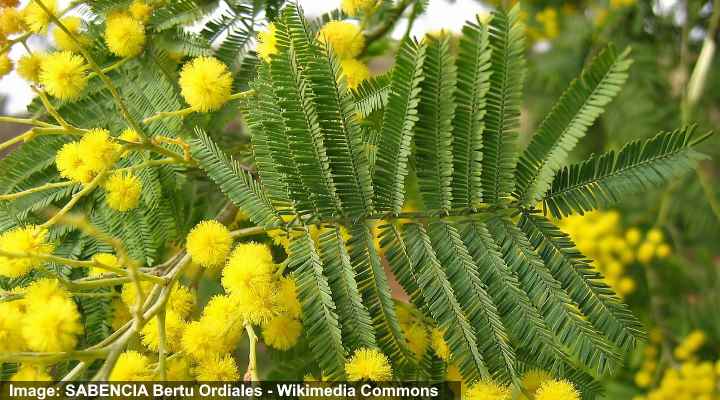
Acacia dealbata leaves and flowers
Silver wattle flowers are large yellow clusters made up of fuzzy globular flowers. The spectacular yellow mimosa flowers bloom profusely on the small tree. Yellow mimosa flowers are so showy that they are often used in cut flower arrangements.
Another feature of the Silver Wattle is the long, flattened brown pods that contain several black seeds.
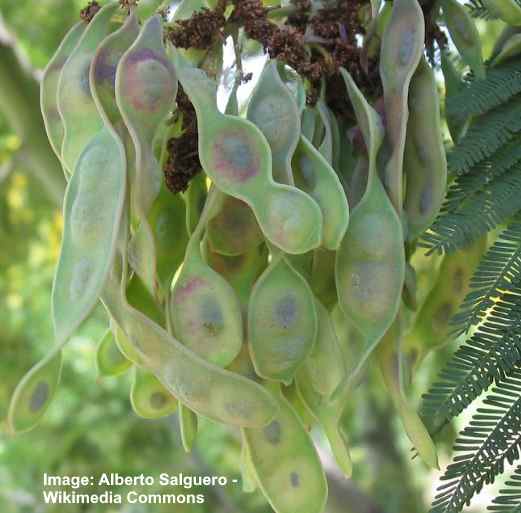
Acacia dealbata immature pods
Acacia Confusa
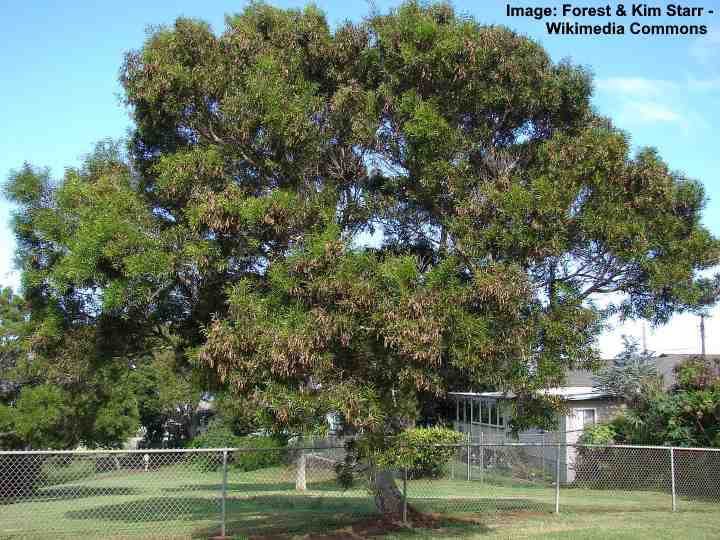
Acacia Confusa tree
The Acacia confusa is a medium shrubby acacia with green, leathery lanceolate leaves and small round furry-looking yellow fragrant flowers. Also called the small Philippine acacia or Formosa acacia, this large shrub or medium-sized tree grows up to 50 ft. (15 m) tall.

Acacia confusa flowers and leaves
Acacia confusa fruit are dark brown or black twisted or curved pods, each containing eight brown seeds.
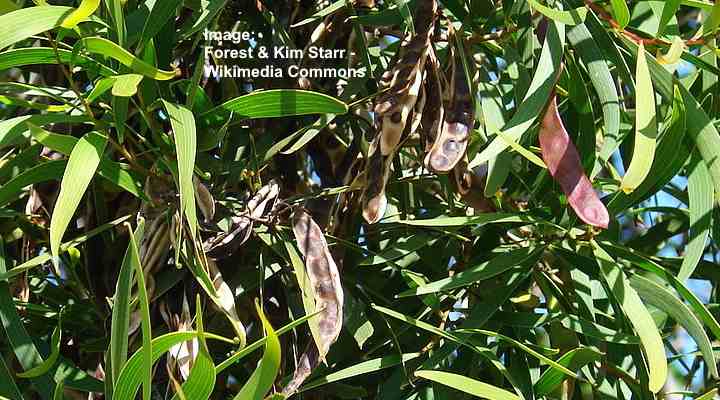
Acacia confusa pods
Creeping Wattle (Acacia saligna)
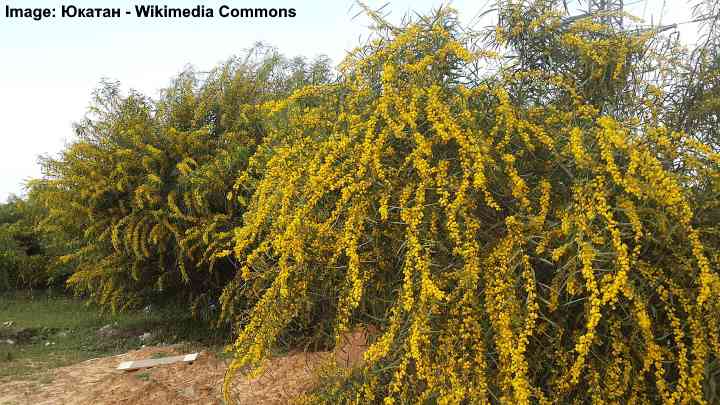
Creeping Wattle (Acacia saligna)
Also called the Blue Leaf Wattle, the Creeping Wattle is a shrub-like tree with elongated leaves, clusters of bright yellow flowers, and long brown seed pods. Creeping Wattle trees are small shrubby, multi-stemmed trees growing around 6.5 to 19 ft. (2 – 6 m) tall.
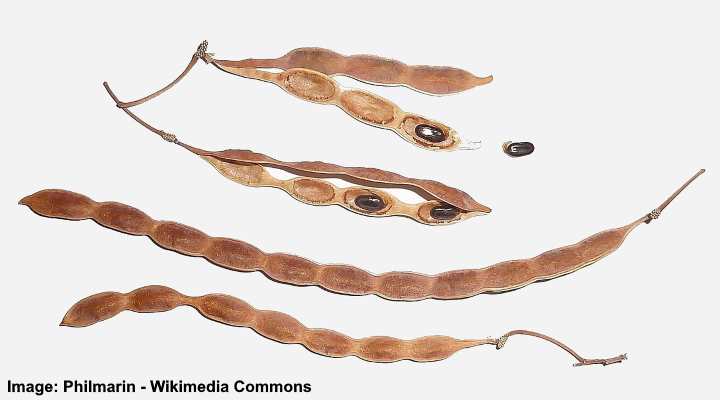
Acacia saligna pods and seeds
Like many acacias, the young tender leaves are bipinnate before becoming long willow-like leaves. The drooping leaf growth gives the Creeping Wattle a weeping look.
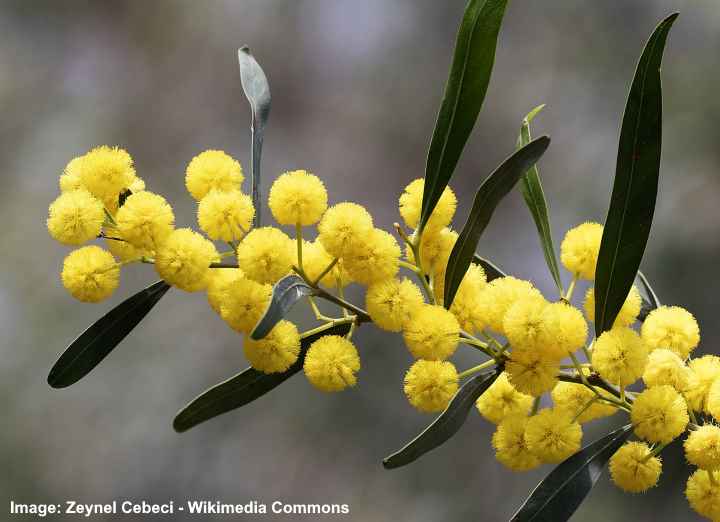
Acacia saligna flowers and leaves
Numerous golden-yellow fluffy flowers grow in large globular clusters on hairless branches.
Flax-Leaf Wattle (Acacia linifolia)

Acacia linifolia young tree
The Flax Wattle is a small shrubby tree that grows between 5 and 13 ft. (1.5 – 4 m). This “white wattle” has evergreen linear leaves (phyllodes) that are up to 2” (5 cm) long. The long leafy stems also produce clusters of pale yellow or creamy-white flowers. Flax-Leaf Wattles bloom in summer and winter. Growing in USDA zones 9 through 11, the small trees thrive in full sun or partial shade.
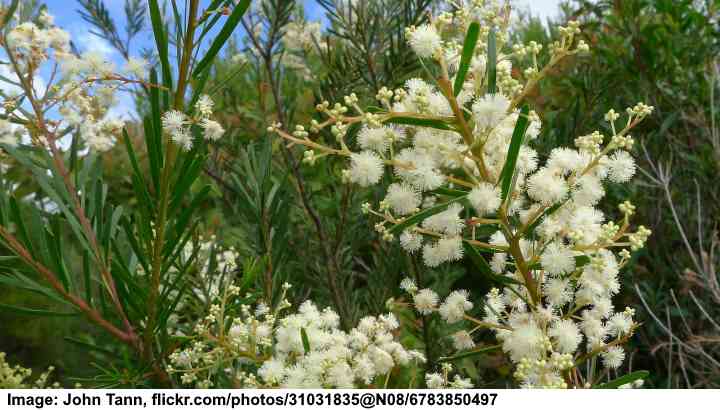
Acacia linifolia leaves and flowers
Related articles:
- The Best Desert Trees with Pictures and Names
- Types of Locust Trees with Identification Guide
- Mesquite Trees Types – Identification Guide
